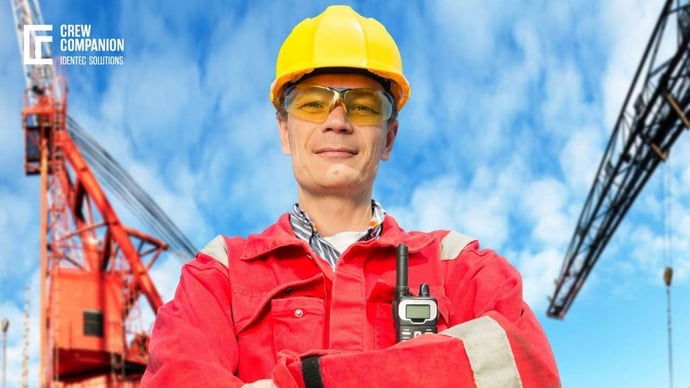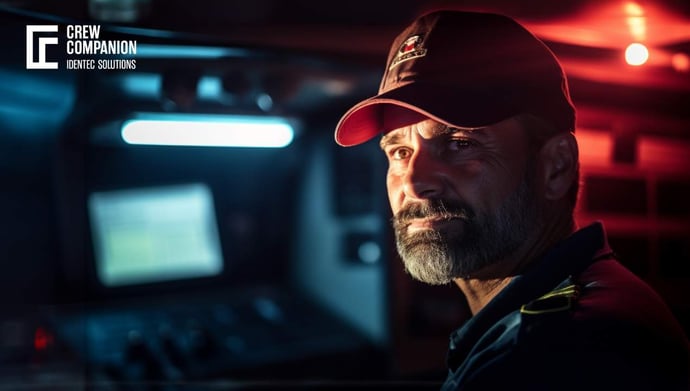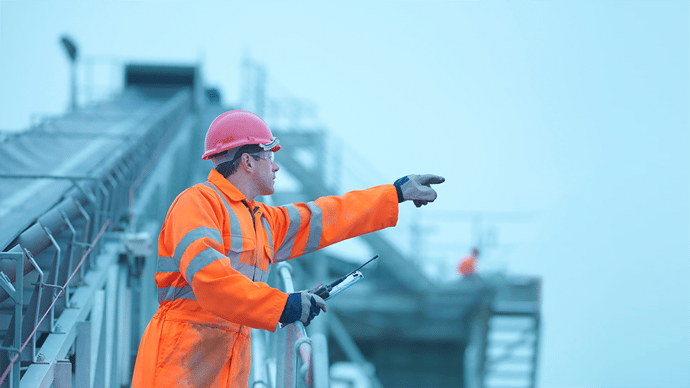Wearable Technology History in Offshore Oil&Gas
| Written by Michal Wozniakowski-Zehenter

No video selected
Select a video type in the sidebar.
What are the Early Beginnings of Wearable Technology History?
Wearable technology is not a new concept; it can even be traced back to simple devices created to serve specific functions while being worn on the body. In the offshore oil and gas industry, earlier forms of wearable technologies focused primarily on safety and communication.
During offshore drilling activities in the mid-20th century, workers wore protective gear such as helmets, gloves, and boots to protect them from physical dangers. By no means "technology" in today's parlance, these types of wearables had established a foundation for functional equipment set into everyday work attire. One of the industry's first usages of electronic, wearable-type devices was two-way radios in the 1950s. These were portable communication tools, maintaining contact across expansive, complex offshore platforms and ensuring coordination in emergencies.
It wasn't until the 1970s, when more advanced electronics were available, that the first wearable gas detectors hit the market. During this period, such devices played a crucial role in detecting dangerous gases like hydrogen sulfide and warning workers of hazardous situations in real time to prevent disasters. Although these early gas detectors seem relatively primitive compared to today's models, they were a huge step forward in utilising wearable devices for safety monitoring.
Wearable Technology History: Advancements in the Late 20th Century
The latter half of the 20th century was when really impressive technologies came into existence and started to play a huge role in wearable technology with offshore operations. In this regard, the miniaturisation of electronics, elongation in battery life, and enhanced sensing technologies have provided the possibility of more advanced and functional wearable devices.
During the 1980s, wearable communication devices began to shrink and grow more efficient. Bulky handheld radios gradually gave way to hands-free headsets, allowing workers to communicate without tying up their hands for operational tasks. This development was especially appropriate for hands-on environments where manual dexterity and response time are important.
Significant advancements in sensor technology occurred in the 1990s. Wearable gas detectors became more sensitive, reliable, and capable of detecting a greater range of hazardous substances. It was a time when the incorporation of digital displays and audible alarms significantly enhanced the user interface and response times for these devices. During this decade, wearable location tracking systems began to appear that utilised early forms of Global Positioning System technology. These systems provided an effective way of keeping track of the whereabouts of personnel over extensive offshore platforms and hence improved safety management and coordination of emergency response (see also our whitepaper about rig safety and how to improve the emergency response).
Wearable Technology History: Digital Transformation and Smart Wearables
Offshore oil and gas are no exceptions and have faced a similar digital revolution across various industries during the turn of the 21st century. Thus, with the omnipresence of digital technologies and wireless communication, the Internet of Things burst into the development of smart wearable devices.
Smart helmets began to make inroads offshore in the early 2000s. These helmets integrated communication systems, monitoring the environment in which the worker is and transmitting, and at times, cameras which allowed a worker to send real-time data and vision to teams or centres onshore; this way, remote monitoring was possible. Higher levels of monitoring have been achieved in providing support for better decisions and operational efficiency.
This was simultaneous with wearable health monitoring devices starting to gain prominence. These wearables were capable of monitoring vital signs, like heart rate, body temperature, and tiredness levels, very effectively—precise data that would be critical to the health and safety of workers working in harsh offshore environments. The consequence of this role was quite important for the monitoring of exposures to extreme temperatures, physical stresses, and stress while averting potential illnesses or problems and ensuring adherence to occupational health standards.
This has further been supplemented by the development of wearable devices for use in offshore sites. They were built to withstand the extreme environmental conditions encountered in offshore worksites and even allowed workers to enter the work location in the field and retrieve different data. This, in turn, minimised the reliance on manual paperwork and eased the logistic process. The addition of barcode scanners and RFID readers in the use of wearables further allowed for efficient inventory management and equipment tracking on offshore platforms (see also: Emergency mustering).
Wearable Technology History – Today
The mid-2010s were really a rebirth for wearable technology, which was now more powerfully connected, data-intensive, and interoperable with broader operational systems. Maturity of the IoT, combined with other arising technologies such as AI and AR, had highly expanded the functioning area of wearable devices within the context of the offshore oil and gas industry.
Some of the prominent innovations of that time were smart glasses and AR headsets. These devices empowered workers with real-time information overlays, interactive manuals, and remote expert access in frontline operations for complex tasks. For example, they could retrieve step-by-step instructions with visual cues right in their field of vision to guide them through a series of tasks, reducing mistakes and saving time on training. Enabling live video feeds to stream meant bringing in experts from anywhere in the world for instant advice on how to solve a problem—in other words, reduced production loss.
Exoskeletons represented another groundbreaking advancement in wearable technology. Designed to augment human strength and reduce physical strain, exoskeletons became valuable tools for workers involved in heavy lifting and repetitive tasks. By distributing weight and supporting proper posture, these devices helped prevent musculoskeletal injuries and improved overall productivity.
Advanced environmental sensors embedded in wearable devices provide for advanced safety monitoring. Multi-gas detectors, noise level monitors, and radiation sensors assess the environment fully to allow for proactive hazard identification and mitigation. Besides, wearables with fall detection and man-down alerts become critical for ensuring prompt emergency responses to any accidents that may happen.
Connectivity had to go to the very heart of maximising these wearables. Using robust wireless networks, data gathered by these multiple wearable devices could be integrated and analysed together in real-time. This facilitated predictive maintenance and hazard forecasting with informed decision-making. For example, continuous monitoring of the equipment operators' vital signs and environmental conditions might predict fatigue-related risks and schedule timely breaks to prevent accidents.
Wearable Technology History: How Did it Impact Offshore Operations?
The embrace of wearable technologies has influenced some offshore oil and gas operations. It has dramatically improved safety by providing real-time monitoring with an advanced warning system to take precautionary measures to prevent accidents and health complications. The technology makes it possible to continuously track parameters for environmental conditions, such as temperature and gas levels, and the workers' health parameters. This allows for a fully proactive approach to safety management.
Wearable devices have also significantly enhanced operational efficiency. The devices can immediately communicate and obtain data on the move, speeding up the workflow and time responsiveness. Maintenance and repair have been improved by integrating AR with wearable computing, which provides affordable and quick access to technical information and expert support in real time to minimise equipment downtime.
In addition, wearable technology contributes to better compliance and reporting. Automated data collection and logging ensure that necessary safety checks, environmental monitoring, and operational activity are documented accurately and promptly, but they also ease the compliance process by providing valuable data for continuous improvement initiatives.
Wearable devices can positively influence workforce training and competence development. AR wearables allow interaction and immersion that lead to effective learning through practical skill in a controlled, safe environment. This fastens skill acquisition processes and ensures the level of readiness for operations is much greater in reality.
FAQ
How has wearables technology influenced the offshore oil and gas industry?
Wearable technology has significantly influenced the offshore oil and gas industry by enhancing safety, efficiency, and operational effectiveness. Initially, basic protective gear and early communication devices like two-way radios laid the foundation for integrating technology into daily operations. Over time, advancements such as wearable gas detectors, smart helmets, and health monitoring devices improved real-time hazard detection and worker safety. The advent of digital wearables in the 21st century, including AR headsets and exoskeletons, revolutionised training, remote support, and heavy lifting tasks, minimising errors and injuries. These innovations have streamlined workflows, reduced downtime, and improved regulatory compliance, making operations safer and more efficient. As wearable technology continues to evolve, its influence will likely deepen, driving further advancements in predictive maintenance, remote operations, and overall industry sustainability.
TAKEAWAY
The journey of wearable technology in the offshore oil and gas industry has been constant innovation toward improved safety, efficiency, and productivity within arguably one of the most challenging work environments globally. From humble beginnings with protective gear and basic communication devices, wearable technology has become an integral component of today's sophisticated offshore operations.
With advancing technology and changing operational paradigms, wearables will undoubtedly be more integrated and intelligent in their future capabilities. The ability of offshore oil and gas industries to grapple with these developments and solve associated problems will be important in unlocking this potential while maintaining a safe, efficient, and forward-looking industry in years to come.
Delve deeper into one of our core topics: Emergency Response Management
Glossary
A two-way radio is a communication device that allows users to send and receive audio transmissions over radio frequencies. Unlike a regular radio, which only receives signals, a two-way radio enables real-time, bidirectional communication. It is commonly used in industries such as offshore operations, emergency services, construction, and security due to its reliability in remote or hazardous environments. Two-way radios operate on either analog or digital signals and can function on licensed or unlicensed frequencies. They typically include features like push-to-talk (PTT), multiple channels, encryption for secure communication, and long battery life.
In offshore operations, two-way radios are critical for ensuring crew safety, coordination, and emergency response. They allow workers on oil rigs, ships, and wind farms to maintain constant contact, even in areas without cellular coverage. Rugged, waterproof models are often used in these harsh conditions. Two-way radios remain essential for efficient and reliable field communication. (2)
Sources:
(1) https://www.offshore-mag.com/business-briefs/equipment-engineering/article/14296604/wearable-technologies-helping-to-protect-offshore-personnel
(2) https://en.wikipedia.org/wiki/Two-way_radio
Note: This article was updated on the 7th of March 2025

Author
Michal Wozniakowski-Zehenter, Marketing Manager
Michal Wozniakowski-Zehenter is an experienced marketing and project management professional. He spent most of his career on projects with a strong focus on digital marketing and event management. He is a very active voice representing offshore and mining industries through social media channels. Michal writes mainly about offshore oil and gas, renewable energy, mining and tunnelling. Compiling and sharing the knowledge within industries is one of his goals.




